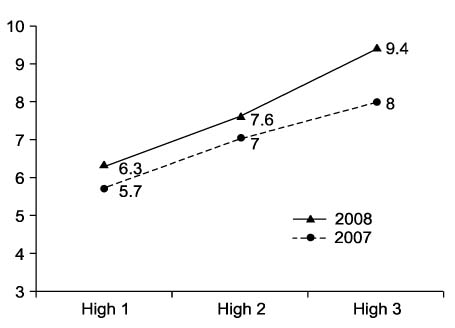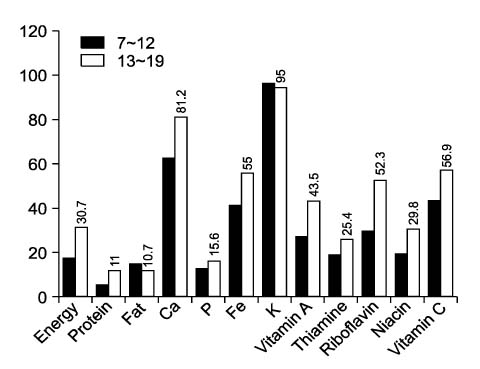Korean J Pediatr Gastroenterol Nutr.
2010 Dec;13(Suppl 1):S10-S14. 10.5223/kjpgn.2010.13.Suppl1.S10.
Current Nutritional Status of Korean Adolescents and Countermeasures
- Affiliations
-
- 1Department of Pediatrics, Inje University Ilsan Paik Hospital, Goyang, Korea. jsmoon@paik.ac.kr
- KMID: 2275461
- DOI: http://doi.org/10.5223/kjpgn.2010.13.Suppl1.S10
Abstract
- The importance of healthier nutrition and lifestyle in children and adolescents is growing more and more nowadays in the era of exponential increase of chronic diseases, such as cardiovascular diseases, diabetes mellitus, hypertension and hyperlipidemia. But the situation of the adolescent nutrition in Korea looks no so good. According to the several recent surveys in Korea, 67% increase in obesity during the past decade was striking. Prevalence of wasting in school girls was increasing, which were accompanied by high prevalence of eating disorder prone factors. Unhealthy eating behavior and selective deficiency of nutrient intake were common. Calcium and potassium were the most common deficient minerals of adolescents, whose usual dietary intake was below Korean Recommended Guidelines. To meet the upcoming challenges of nutrition in adolescence, we should prepare the new multidisciplinary policy including healthier school nutrition environment and enrollment of the health care clinics or hospitals as primary prevention providers.
Keyword
MeSH Terms
-
Adolescent
Calcium
Cardiovascular Diseases
Child
Chronic Disease
Delivery of Health Care
Diabetes Mellitus
Feeding and Eating Disorders
Feeding Behavior
Humans
Hyperlipidemias
Hypertension
Korea
Life Style
Minerals
Nutritional Status
Obesity
Potassium
Prevalence
Primary Prevention
Strikes, Employee
Calcium
Minerals
Potassium
Figure
Reference
-
1. Stang J, Story M. Guidelines for adolescent nutrition services. 2005. Minneapolis, MN: Center for Leadership, Education and Training in Maternal and Child Nutrition.2. Hagan JF, Shaw JS, Duncan PM. Bright futures: guidelines for health supervision of infants, children, and adolescents. 2008. 3rd ed. Elk Grove Village, IL: American Academy of Pediatrics.3. Oh K, Jang MJ, Lee NY, Moon JS, Lee CG, Yoo MH, et al. Prevalence and trends in obesity among Korean children and adolescents in 1997 and 2005. Korean J Pediatr. 2008. 51:950–955.
Article4. Adolescent health. WHO. Accessed 25 November, 2010. at http://www.who.int/topics/adolescent_health/en.5. Kliegman R, Nelson WE. Nelson textbook of pediatrics. 2007. 18th ed. Philadelphia: Saunders.6. The Third Korea Youth Risk Behavior Web-based Survey. 2008. Seoul: Korea Centers for Disease Control and Prevention.7. Moon JS, Lee SY, Nam CM, Choi JM, Choe BK, Seo JW, et al. 2007 Korean National Growth Charts: review of developmental process and an outlook. Korean J Pediatr. 2008. 51:1–25.
Article8. Moon JS, Lee CG, Hwang SS, Park HW, Lee HK, Lee GO. Analysis of 2007 school health examination data and development of revisional plan for the school health screening system in Korea. 2008. Ministry of Education, Science and Technology.9. Lee KO, Moon JS, Hwang SS. Analysis of 2008 school health examination data and sample design for 2009 school health survey. 2009. Ministry of Education, Science and Technology.10. Food behavior associated with obesity in Korean Adolescents - Survey for the adolescent's thinking about obesity and weight control. 2010. Korea Food and Drug Administration.11. The Third Korea National Health and Nutrition Examination Survey (2005). 2006. The Korea Health Industry Development Institute, Ministry of Health and Welfare.12. Gidding SS, Dennison BA, Birch LL, Daniels SR, Gillman MW, Lichtenstein AH, et al. Dietary recommendations for children and adolescents: a guide for practitioners. Pediatrics. 2006. 117:544–559.
Article13. Dietary guidelines for Korean. 2009. Ministry of Health, Welfare and Family.14. Krebs-Smith SM, Reedy J, Bosire C. Healthfulness of the U.S. Food Supply Little Improvement Despite Decades of Dietary Guidance. Am J Prev Med. 2010. 38:472–477.15. Sebastian RS, Wilkinson Enns C, Goldman JD. US adolescents and MyPyramid: associations between fast-food consumption and lower likelihood of meeting recommendations. J Am Diet Assoc. 2009. 109:226–235.
Article16. Scholtens S, Middelbeek L, Rutz SI, Buijs G, Bemelmans WJ. Differences in school environment, school policy and actions regarding overweight prevention between Dutch schools. A nationwide survey. BMC Public Health. 2010. 10:42.
Article17. Durant N, Harris SK, Doyle S, Person S, Saelens BE, Kerr J, et al. Relation of school environment and policy to adolescent physical activity. J Sch Health. 2009. 79:153–159.
Article18. Masse LC, Frosh MM, Chriqui JF, Yaroch AL, Agurs-Collins T, Blanck HM, et al. Development of a School Nutrition-Environment State Policy Classification System (SNESPCS). Am J Prev Med. 2007. 33:S277–S291.19. Diet, Nutrition and the Prevention of Chronic Diseases. Report of a joint WHO/FAO expert consultation. 2003. Geneva: World Health Organization.20. McGill HC, McMahan CA, Gidding SS. Are pediatricians responsible for prevention of adult cardiovascular disease? Nat Clin Pract Cardiovasc Med. 2009. 6:10–11.
Article21. Kelder SH, Perry CL, Klepp KI, Lytle LL. Longitudinal tracking of adolescent smoking, physical activity, and food choice behaviors. Am J Public Health. 1994. 84:1121–1126.
Article22. Story M, Holt KA, Sofka D. National Center for Education in Maternal and Child Health (U.S.). Bright futures in practice: nutrition. 2002. 2nd ed. Arlington, VA: National Center for Education in Maternal and Child Health.
- Full Text Links
- Actions
-
Cited
- CITED
-
- Close
- Share
- Similar articles
-
- Current status of nutritional screening in periodic health examination
- Dietary intake and nutritional status of Korean children and adolescents: a review of national survey data
- Nutritional Support in Patients with Inflammatory Bowel Diseases
- Nutritional status and dietary behavior of North Korean adolescent refugees based on Nutrition Quotient for Korean adolescents: a preliminary study
- Underweight in Adolescents



